Kids, 10, training for to build a workforce for AUKUS, SA’s $368bn nuclear submarine project
This ain’t the classroom you learnt in. A tech firm, a global defence company and SA teachers have teamed up to build an extraordinary new workforce.
SA Weekend
Don't miss out on the headlines from SA Weekend. Followed categories will be added to My News.
There are 14 kids sitting on the floor. All are playing close attention to the teacher at the front of the classroom. Most of them are 10 years old and even though, maybe, a couple are fiddling with their iPads, there is still rapt attention from all involved. No fidgeting, no whispering to each other, just concentration on what “Mr S” is showing them. The only noise in the room belongs to the teacher and chatter leaking through from an adjoining class. These are year 5 kids at Elizabeth Downs Primary School.
What the teacher is demonstrating is a new way of teaching kids. A method that wants to move away from the more passive teacher and textbook approach to something that embraces virtual technology and augmented reality.
Today Mr S is showing his students how to create 3D digital designs using a program called Tinkercad. A room next door is full of VR glasses, AR cubes, robots designed by students, drones, drone gates and a 3D printer.
It’s a long way from teachers writing on blackboards with crumbling white chalk.
These kids are part of a pilot program called Beacon that wants to hook kids on the kinds of subjects that we keep being told they don’t do enough of. Science, technology, engineering and maths. Or to give it its catch-all title – STEM. The subjects everyone laments that not enough kids study these days, especially as Australia rushes headlong into a future where it hopes to build nuclear submarines and other assorted
hi-tech defence toys.
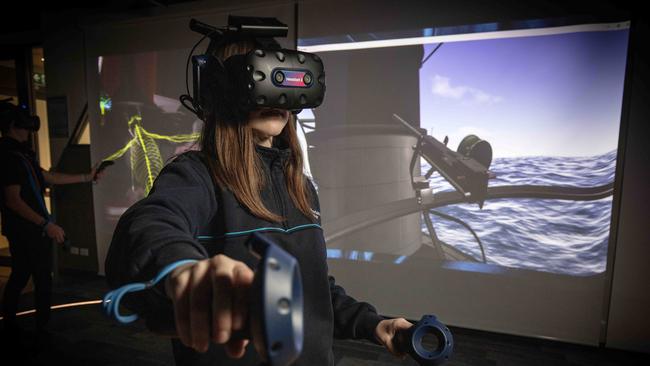
One of the students sitting on the floor is 10-year-old Crowley Flynn. Crowley already has his sights set on delivering those nukes for Australia.
“I really want to work with the subs and be a boilermaker,’’ Crowley says. “A lot of my family do trades and I want to work building the subs.”
Crowley, along with his classmates Emma Schedewy and Lucas Taylor are loving the new class. Emma has her sights set on becoming a scientist, possibly working in the field of climate change, while Lucas is another who sees himself working on Australia’s future submarine program, possibly in the research field.
“It’s so much better because we can actually do stuff, rather than thinking about how to do stuff,” Emma says. “It’s definitely more interesting when you can use your creativity.”
Crowley, Emma and Lucas may already be converts to this new world, but the numbers show that even children who are interested in subjects such as science and maths in primary school lose the passion as they become older and the subjects become more complex as they enter high school. There is also the natural focus many students and their families place on achieving a good ATAR score, which can lead to kids ditching harder science and maths subjects.

A recent study by the Australian Mathematical Sciences Institute showed high school enrolments in advanced maths subjects dropped to a historic low in 2020.
The Institute found just 9.2 per cent of students studied high-level maths, down from 11.6 per cent in 2008. Enrolments in intermediate-level maths plunged from 23.3 per cent in 2008 to 17.6 per cent in 2020. Which, with forecasts that the state will need a workforce of around 10,000 highly educated, highly qualified people to build the subs, is something of a worry.
The Beacon program that is captivating the students at Elizabeth Downs is run by a technology company called Lumination and also involves defence and shipbuilding company BAE. It’s the second year for Beacon, which started at Northfield and Enfield primary schools last year for students in years 4 to 6.
This year more than 600 students from South Australia, Victoria, Western Australia and New South Wales will take part in the program.
The idea is to spark the imagination of students through the use of virtual and augmented reality, coding, robotics, artificial intelligence and 3D modelling. There has already been a tour of the Osborne shipyard where the submarines will be built. There is also an “intensive’’ camp where all the kids come together for a weekend.

Outside of the classroom Mr S is Shane Singlehurst. He is the STEM specialist at Elizabeth Downs Primary School and thought Beacon would bring new opportunities to the school. Elizabeth Downs is ranked by the state’s education department as a category one school, making it one of the most disadvantaged in South Australia.
“Some of the students come from third and fourth generations of unemployment and we are just trying to get them out of that cycle and have ambitions and explore possibilities,” Singlehurst says. “They are going to end up in jobs that don’t exist at the moment.”
Singlehurst says his students are already more engaged with learning because Beacon is more hands-on and encourages creativity.
The school runs a lunchtime robot group and has done well in various competitions with other schools. “Hopefully, when they get to high school they will continue with the program,” Singlehurst says. “They become creators and not just users which is what I love.”
A 15-minute drive from Elizabeth Downs is Riverbanks College in Angle Vale. It’s a brand new public school. It’s billed as a reception to year 12 school, but is so new that the oldest students in the place are the year 9s.
It feels modern as you enter through the sliding doors. Big and airy with new carpets and that fresh paint feel. It also has a Lumination Learning Lab. This is about as far from a traditional classroom as it is possible to be.
In the room are what look like three small podiums sitting in a defined circle a couple of metres across. But on the stands hang virtual reality goggles. On the walls are large screens. The screens mirror what the student wearing the VR goggles is seeing and doing. On one screen, a student is working her way through an anatomical musculoskeletal model. She can remove muscles and bones, examine them, put them back together. In the right order or even not. The idea is to play around and understand how the body works. On the next screen is the Iron Wolf submarine. The user is immediately dropped on to the control deck of the submarine and surrounded by glowing dials that show depth and pressure and speed. If you are wearing the goggles, you can reach out and manipulate the controls to use the periscope or surface the sub. You can also load torpedo tubes or climb on to deck and fire the machine gun.
It all sounds and feels like the world’s best computer game but there is a serious point as well in teaching students a little about navigating these machines and how they work.
The third screen allows students to create anything they like. They can walk around the model, manipulate it with their hands, then when they are done, print it out. It could be used for anything from architecture to car design.
Michael Bolderoff has been building a spaceship. The 14 year old thinks he may be headed to architecture or engineering after finishing school, and while this is his first experience with VR, he can already see the benefits. “This really helps me exploring different structures,” he says. “You can build and experience it, rather than just reading about it or doing a drawing. I can see what works and what doesn’t and whether it’s good or not.”
Cora Scarlet has been working in the Iron Wolf submarine. She has pulled the levers that bring the sub up from the depths, has sighted an enemy ship in the distance and jumped up on deck to repel an invader with a deck gun.
She says it was easy to use and follow instructions and it gave more “in-depth knowledge’’ than just reading about it.
“It’s a lot more fun, it’s like playing a video game but it’s a lot more educational,” she says.
Their teacher Rowan Hearne is the senior leader for learning technology and data intelligence at Riverbanks. He co-ordinates the program for the school, which runs from students in year 5 and will ultimately make it all the way to year 12. Hearne says while the students enjoy the video game aspect of the VR learning, “we don’t want it to become a toy” and it was “more about how we embed this and build it into the curriculum”.
The plan is for every class in the school to use the lab at least once or twice a term and as the students became more used to the technology they would become more creative in how they use it. He reinforces the point made by Shane Singlehurst at Elizabeth Downs, that the challenge for teachers is preparing children to do jobs that perhaps don’t exist as yet.
“Technology is not exactly going to go backwards is it?” he asks.
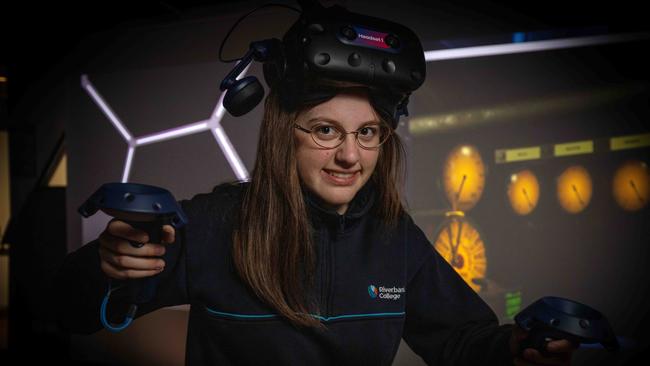
Lumination Labs have been installed at a number of newly built government schools. As well as Riverbanks, there are labs in new schools at Whyalla, Aldinga, Goolwa. The private girls’ school Loreto has a VR lab. Lumination itself is an Adelaide-based company that started in 2016, with its headquarters between a coffee shop and a microbrewery in Thebarton.
The company’s chief commercial officer Tom Hastwell is unapologetic about the company’s aims. “If you want to get evangelical about it, we really want to disrupt the standard rote way of learning in class in schools,” he says.
The company is now talking to schools overseas about their technology. Unsurprisingly, this kind of kit doesn’t come cheap. It starts at around $200,000 just for the hardware, but Hastwell says it’s not just about the technology. It’s about trying to drive a change in culture in school and making sure VR and AR is not just another passing fad. “There’s a litany of examples where digital technology has gone into schools, and no one has known how to use it,” he says.
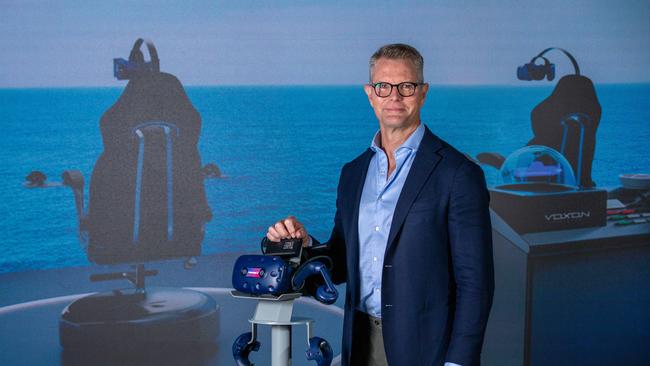
So part of the deal is that Lumination supports the schools for three years and possibly longer to ensure the technology is used to its potential. Daniel Becker is another Lumination employee. A former chemistry teacher, Becker is now the company’s education programs co-ordinator and believes this form of teaching is a natural fit for the children of today who grow up surrounded by technology and understand how it works and how it can be used. “It’s here already,” he says. “They use VR. They use mobile devices. It’s in their everyday life.”
And Becker says it’s working. Children are more engaged with this style of learning than with the more traditional methods.
“We do see an increase in engagement, retention of information and a liking for those more maths, science, tech subjects that they probably didn’t want to do before,” he says.
To make the point, Becker talks about his own background in the classroom. How, to take one example, it can be difficult to impress on a student the size of an atom.
“But once you can visualise it, once you can see it and manipulate it or touch it using all your different senses, then that retention, that comprehension is increased,’’ he says.
“And a lot of kids are very visual these days.”
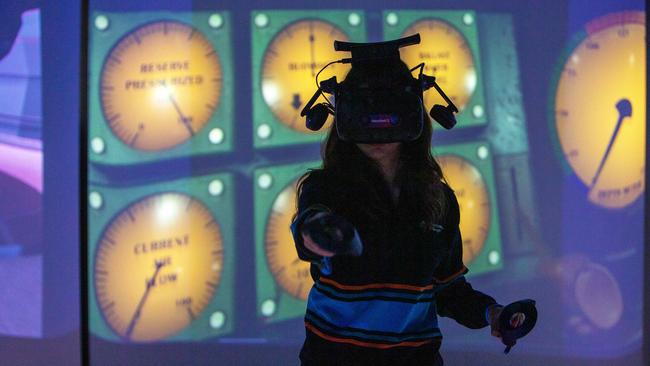
Lumination’s Beacon program will reach more than 500 students around Australia and crucially, the company says, almost 50 per cent of participants are girls, who traditionally are under-represented in STEM careers.
Around 7 per cent of the students come from Indigenous backgrounds, with another of the program’s objectives being to encourage more First Nations kids into maths and science.
Beacon has also been run in the United Kingdom at Barrow-in-Furness, which is home to that country’s nuclear shipbuilding program.
“The thinking behind that is that a student 10-11 years old is starting to understand the concept of work, and also understand what they’re good at,” Hastwell says.
“Those students that did Beacon last year, in 10 years’ time when the lights are going to get turned on down at Osborne, they’re going to be walking out of their apprenticeship or their degree, hopefully with an opportunity that started back, or an awareness that started back 10 years or so ago.”
According to Lumination’s research into the first year of the program, it produced a 17 per cent increase in the number of students nominating maths and digital technologies as their favourite subject and a 40 per cent jump in those who nominated science. Hastwell also says that when the 10-week Beacon program kicked off only 64 per cent of students had an idea of what they wanted to do when they left school – with many of those nominating doctors, barbers, YouTubers and soccer players.
After Beacon, “student perception towards STEM subjects improved across the board, with 80 per cent looking forward to a career as an engineer, video game developer, animator, PC builder, scientist and other STEM-related roles”.

BAE’s partnership with Lumination started when the giant UK-based defence companyasked itself if it was doing enough to encourage young kids into subjects that would produce future workers. BAE had various small-scale programs done through a number of providers but decided a more unified approach was needed to reach more students. BAE asked for applications and Lumination was chosen.
Georgette Elston is head of resourcing and early careers at BAE Systems Australia. Elston doesn’t hold back in describing the challenges faced by BAE when it comes to recruitment. It’s already employing 1000 people a year and that rate is not likely to slow. “Graduate recruitment over the last couple of years has, since Covid, become really competitive,” she says. “This year, I’m calling it bloodsport.”
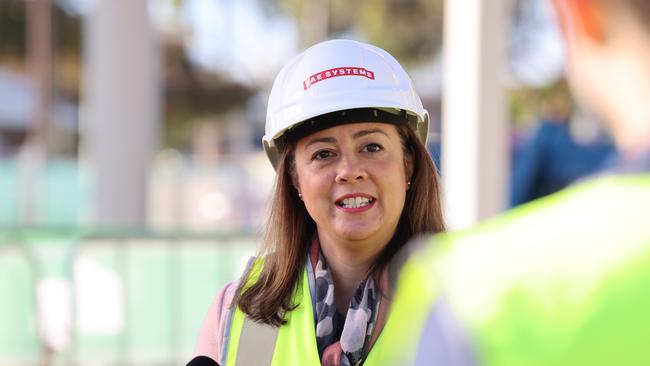
The problem, from BAE’s perspective, is that if you are an engineering graduate as soon as you set foot outside uni you can expect multiple job offers. The job market is so competitive existing workers have plenty of opportunities to jump ship. It means Elston and BAE have to take a longer-term approach to build a bigger pipeline of potential workers. It helps if you start early. Another issue is that given the security implications of working in defence, and the difficulties in obtaining security clearances, domestic students are a priority.
Elston says it’s important to diversify the workforce as well, especially bringing in more female workers, which makes Beacon particularly important. “Year 3 is when girls start to say, ‘I’m not good at math’,” Elston says.

“So having an intervention at that point, keeping them excited about math and technology is important. And then we can build from there in the future years.”
She says more must be done to support teachers who can be wary of new technology. The most pressing shortages are in systems and software engineering. It means BAE focuses on more than just primary school children. It is working with the state government at its new Findon Technical College and with universities.
State education minister Blair Boyer acknowledges the problem “particularly with AUKUS and the submarine build” on the way.
Boyer says the government will also consider investing in Beacon and would like to see such programs available in more schools.
“I haven’t got a target in terms of numbers, but we’ve got to roll it out for a lot more, it’s got to become basically something we do everywhere eventually,” he says. “And certainly it’s something that we’re making sure is embedded into the new schools that we build.”
Boyer also sees this style of technology as a way to generate more equitable outcomes in schools. That it will be used in schools such as Elizabeth Downs and not just kept to wealthy schools who can afford the investment in equipment and in retraining teachers.
“The benefits, particularly for a state like ours that has a small population and a large area, are particularly pronounced because in a place like Coomandook (in the upper South East) or somewhere in the APY Lands, it’s not possible to offer the same level of opportunity, but VR and the rollout of the NBN means we actually can deliver in those places,” he says.
Back at Elizabeth Downs, Crowley, Emma and Lucas are thinking about the future. Crowley is using Tinkercad to design a new way to keep fruit fresh for longer, Emma wants to solve climate change and Lucas is researching submarines. As Lucas says: “It’s way more fun. And it’s a lot more educational because we have got the chance to do stuff.” ■


